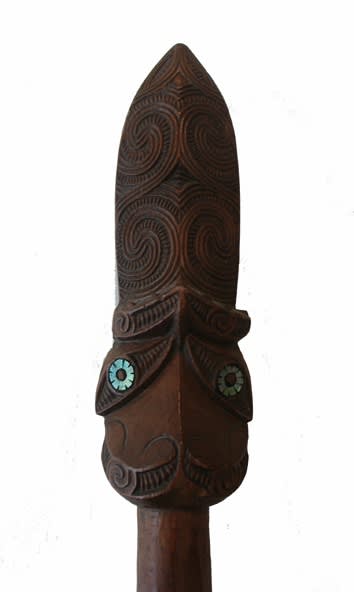Maori: Tradition and Object: Group Exhibition
Maori: Tradition and Object brings together a collection of important Maori artefacts displayed alongside the luminous paintings of Gottfried Lindauer.
The collection of artefacts includes fish hooks, adzes, pounder stones, weapons and traditional carvings, some historical and by unknown artists, others contemporary by Maori artist Te Kaha. Amongst the treasures are mere, used as weapons and symbols of chieftainship; adze, used either handheld or tied to string for cutting trees and other items; patu muka, instruments which pound the inner fibres of flax enabling it to be used for clothing, plates, ropes, baskets, fishing lines and nets; taiaha, a weapon made up of three parts, the orrero (tongue), used for stabbing, the upoko (head), the base from which the tongue protrudes and the ate (liver), or tinana (body), the long flat blade used for striking or parrying.
Maori: Tradition and Object brings together a collection of important Maori artefacts displayed alongside the luminous paintings of Gottfried Lindauer.
The collection of artefacts includes fish hooks, adzes, pounder stones, weapons and traditional carvings, some historical and by unknown artists, others contemporary by Maori artist Te Kaha. Amongst the treasures are mere, used as weapons and symbols of chieftainship; adze, used either handheld or tied to string for cutting trees and other items; patu muka, instruments which pound the inner fibres of flax enabling it to be used for clothing, plates, ropes, baskets, fishing lines and nets; taiaha, a weapon made up of three parts, the orrero (tongue), used for stabbing, the upoko (head), the base from which the tongue protrudes and the ate (liver), or tinana (body), the long flat blade used for striking or parrying.
Alongside the weapons, traditional carvings from the entrances of Wharenui (meeting houses) are shown in the form of a Poupou (carving from the entry of a Wharenui) and a lintel (carved slab from above a meeting house entrance). A Wharenui, the main landmark of a Maori settlement and focal point for tribal pride, is treated with great respect. A Wharenui is regarded as sacred, especially the front of the house where the lintel and Poupou would have originally been placed. The lintel in turn is considered the most important carving, marking the passage from the domain of one god to that of another. Outside the meeting house is often referred to as the domain of Tumatauenga, the god of war, and thus of hostility and conflict. The calm and peaceful interior is the domain of Rongo, the god of agriculture and other peaceful pursuits.
The two paintings exhibited on the back wall of the gallery are by renowned Maori portrait painter, Gottfried Lindauer. Lindauer was a Czech born artist who studied at the Academy of Fine Arts Vienna before emigrating to New Zealand to avoid being drafted to the Austrian military service. On arrival many Maori chieftains commissioned his work, which accurately records their facial tattoos, clothing, ornaments and weapons. The two portraits hanging in Maori: Tradition and Object portray Chief Ngatai and Chieftainess Ngatai and were painted in 1884.






